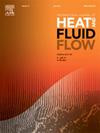Numerical study and moth flame optimization of thermal–hydraulic performance of fractal microchannel heat sink with ribs and cavity
IF 2.6
3区 工程技术
Q2 ENGINEERING, MECHANICAL
International Journal of Heat and Fluid Flow
Pub Date : 2025-02-17
DOI:10.1016/j.ijheatfluidflow.2025.109777
引用次数: 0
Abstract
With the fast integration and shrinkage of electronic equipment, managing heat has emerged as a key roadblock to developing microelectromechanical systems. This investigation presents a bio-inspired fractal microchannel heat sink (FMCHS) design featuring ribs and cavities, which is motivated by the natural mass and energy transfer capabilities found in fractal structures. For an in-depth understanding of the thermal–hydraulic performance of an FMCHS, the branching ratios in successive tree-like structures are chosen via a parameter optimization process that prioritizes minimizing flow resistance. Different thermal and flow characteristics were analyzed numerically using Ansys Fluent, and these results were compared with a plain FMCHS (FMCHS-P). The outcomes suggest that incorporating variable cross-sectional structures can enhance the thermal performance of the FMCHS. FMCHS with ribs (FMCHS-R) and FMCHS with diagonally positioned ribs (FMCHS-DR) have the highest heat transfer performance, followed by FMCHS with cavities (FMCHS-C) and FMCHS with diagonally positioned cavities (FMCHS-DC), but at the same time, ribbed-configured FMCHS has the highest pressure drop. FMCHS models were optimized using ANN and the moth flame optimization (MFO) algorithm with the objective of maximizing Nusselt number and minimizing pumping power and thermal resistance. This research suggests that a model with FMCHS with ribs has an optimal geometrical configuration. The optimal input value is found to be 26 % of the rib radius along all the paths of FMCHS with ribs (FMCHS-R) at a flow rate of 200 ml/min.
求助全文
约1分钟内获得全文
求助全文
来源期刊

International Journal of Heat and Fluid Flow
工程技术-工程:机械
CiteScore
5.00
自引率
7.70%
发文量
131
审稿时长
33 days
期刊介绍:
The International Journal of Heat and Fluid Flow welcomes high-quality original contributions on experimental, computational, and physical aspects of convective heat transfer and fluid dynamics relevant to engineering or the environment, including multiphase and microscale flows.
Papers reporting the application of these disciplines to design and development, with emphasis on new technological fields, are also welcomed. Some of these new fields include microscale electronic and mechanical systems; medical and biological systems; and thermal and flow control in both the internal and external environment.
 求助内容:
求助内容: 应助结果提醒方式:
应助结果提醒方式:


